 Print this Article
Print this Article

By Rabbi Ariel Ovadia
The events leading up to the destruction of the Bet HaMikdash took place during the days of Ben HaMetzarim – the three weeks between the 17th of Tammuz and Tish’a B’Av. To commemorate this terrible tragedy, we observe certain mourning practices. Ribbi Yaakov Skali זצ”ל, student of the Rashba, in his Derashot Torat HaMinha writes, that the mourning practices – such as not bathing or not wearing leather shoes – symbolize the separation of the soul from the body. When an Avel mourns the departure of a Neshama from a body, he does not engage in activities that increase the harmony between body and soul. In a similar fashion, Am Yisrael mourn the disconnect between Hashem dwelling in the Bet HaMikdash – our soul – from the nation. Other tragedies that occurred during this period are also a form of departure of soul from body, such as the breaking of the Luhot and the burning of a Sefer Torah בעוה”ר.
Hachamim blame the Hurban on the fact that people would not recite Birkot HaTorah over the learning of Torah[1]. The Ran in Nedarim[2] quotes Rabbenu Yona who says that not reciting these Berachot was not the cause of the destruction – but rather a symptom of a larger problem: the lack of respect and genuine understanding of the importance of Torah-study for its own sake. It may be said, that this attitude deprived the Torah-study of its “soul”. During this period, we mourn the lost soul of Torah-study and the service of the Bet HaMikdash, which ultimately led to its physical destruction. To rectify this, we must infuse our Torah and service of Hashem with a heart and a soul, and in this merit, we hope to see the return of the Shechina with the rebuilding of Bet HaMikdash, Amen!
Sources:
[1] Bava Metzia 85b [2] 81a